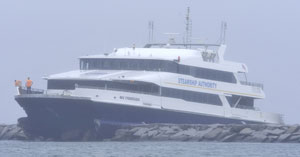The captain of a high-speed ferry apparently confused a metal pole and sailboats for navigational buoys before the vessel slammed into a Cape Cod jetty, injuring 15 people on board.
The 154-foot Iyanough ran into the Hyannis Harbor breakwater at about 2135 on June 16 during stormy weather. The catamaran, carrying 57 people, was traveling at roughly 33 knots before hitting the jetty roughly 1,500 feet north of the main channel.
Wayne Lamson, general manager for the Woods Hole, Martha’s Vineyard and Nantucket Steamship Authority (SSA), said the captain believed a metal pole at the end of the jetty and sailboats moored beyond the jetty were navigational buoys used to guide vessels into the harbor.
“The breakwater itself was not visible on radar because the waves, which were estimated to be 8 feet high at the time, obscured the breakwater’s radar image, while the pole was visible because of its greater height above the waves,” Lamson said in a detailed preliminary report released by the ferry company. “In addition, what the captain had interpreted as buoys 5 and 6 were actually sailboats located on the other side of the jetty. The distances and positions of the pole and the sailboats matched identically to the pattern normally associated with buoys 4, 5 and 6.”
The U.S. Coast Guard is investigating the incident. The SSA, which connects Martha’s Vineyard and Nantucket with mainland Massachusetts, has not released official findings and Lamson declined to speculate on a possible cause.
Iyanough left Nantucket for Hyannis with 48 passengers, six crew and three food service workers roughly 50 minutes before the accident. Winds from the southeast exceeded 30 knots while fog and spotty rain reduced visibility. Estimates of sea conditions ranged from 4 to 8 feet.
The roughly 30-mile crossing was uneventful until the final minutes. According to the SSA, buoy No. 4 is located about 750 feet south of the channel entrance. It provides a visual cue to make a starboard turn toward Hyannis Harbor. Due to reduced visibility, Iyanough’s captain activated the searchlight and asked the pilot to illuminate the navigational buoys as the ferry approached.
When the captain looked back at the radar screen, he recognized a pattern he believed represented buoys No. 4, 5 and 6. He then began adjusting course to enter the Hyannis channel, the SSA said, noting the pilot never located the buoys with the light.
“But what the captain had interpreted on the radar as buoy No. 4 was in fact the metal pole at the end of the breakwater, which is about 800 yards north of buoy No. 4 and also north of the channel entrance,” according to the ferry company’s preliminary findings.
The captain spotted the breakwater just before the collision and attempted an emergency stop. The ferry struck the jetty almost head-on at high speed, according to Coast Guard Lt. John Mansolillo.
Acting Hyannis Fire Chief Dean Melanson said the ferry was traveling east when it struck the seaward side of the roughly 3,500-foot jetty about 1,200 feet from the end. Melanson estimated the vessel should have made a starboard turn 11 seconds earlier to reach the channel entrance.
During interviews with local news crews, passengers described an abrupt jolting stop when the vessel struck the breakwater. The Coast Guard hoisted 15 people from the ferry, five of whom were injured. The remaining 10 were unable to climb down onto the jetty for boat transport to shore, Melanson said. Fifteen people were treated at a local hospital, two of them suffering serious injuries.
All passengers and non-critical crew were off the vessel by 0300 on June 17, Mansolillo said. The 2,200-hp tugboat Morgan helped pull the ferry off the breakwater the day after the accident. Iyanough underwent repairs at Fairhaven Shipyard and was out of service for about a month.
The SSA placed the captain and pilot on administrative leave after the accident while investigators try to determine how the radar images were misconstrued. The two mariners, who have 60 years of combined experience, both tested negative for drugs or alcohol.
“Suffice it to say that we are looking at all potentially contributing factors to this accident,” the ferry company said, “including the actions and operational judgment of the vessel’s captain and pilot.”

